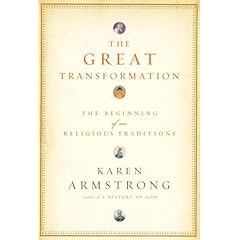 In the list toward the bottom right of this page, you’ll find a link to a New York Times review of a fascinating-sound book called The Great Transformation: The Beginning of Our Religious Traditions, by Karen Armstrong, which looks at one of the earliest turning points in the history of world religion—when “the crowded heaven of warring gods, worshiped in violent rites, lost its grip on the human imagination, which increasingly looked inward rather than upward for enlightenment and transcendence.”
In the list toward the bottom right of this page, you’ll find a link to a New York Times review of a fascinating-sound book called The Great Transformation: The Beginning of Our Religious Traditions, by Karen Armstrong, which looks at one of the earliest turning points in the history of world religion—when “the crowded heaven of warring gods, worshiped in violent rites, lost its grip on the human imagination, which increasingly looked inward rather than upward for enlightenment and transcendence.”
This transformation occurred independently in four different regions during the Axial Age, a pivotal period lasting from 900 B.C. to 200 B.C., producing Taoism and Confucianism in China, Buddhism and Hinduism in India, Judaism in the Middle East and philosophic rationalism in Greece [which, while not monotheism, would “lay the groundwork for what Ms. Armstrong calls the second great transformation, the scientific revolution of the 16th century”]….
In historical time the great transformation is remote. But Ms. Armstrong argues passionately for its relevance to a world still embroiled in military conflict and sectarian hatreds. This is the powerful undertow to her book. “In times of spiritual and social crisis, men and women have constantly turned back to this period for guidance,” she writes. “They may have interpreted the Axial discoveries differently, but they have never succeeded in going beyond them.”
Even further, Ms. Armstrong argues that the radicalism of the great Axial thinkers has yet to be understood. Their notion of the religious life was concerned less with belief systems than with self-transformation. Most were uninterested in questions of theology. “Their objective was to create an entirely different kind of human being,” she writes.